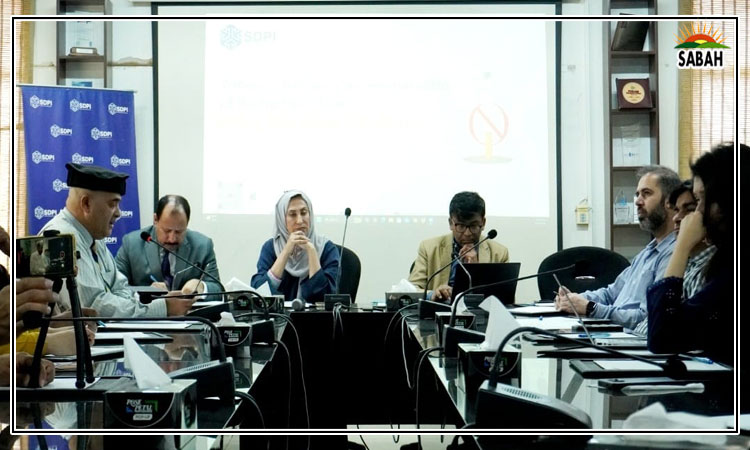Opinion Is climate a security issue? ……… Sherry Rehman
As the planet warms to red every summer, the era of the Anthropocene, or the man-made century, is turning out to be an existential challenge to humankind itself. In all potential futures that map human and national security, the guardrails against conflict are slowly wearing down.
Global warming, the degradation of nature, and national security are largely addressed as separate issues. Today, though, the risks posed by the triple planetary crisis, of climate change, biodiversity losses, and pollution are escalating to pose material risks to societies, nation-states and economies in ways that up-end conventional thinking on security. Traditional threats to global stability, such as conflict, are now compounded by global and national changes in warming, ocean changes, water and food security, while growing unpredictability and extreme weather triggered by high temperatures and stressed natural systems unfold as serial, complex risks to multilateral systems created to maintain global security.
The World Economic Forum’s 2023 Global Risks Report, which brings together the insights of over 1200 experts from academia, business, government, civil society, and the international community, includes six risks that are directly related to nature in its list of top 10 global risks likely to emerge in the next 10 years. Out of this list, three are linked to climate change and the degradation of ecosystems. These include large-scale involuntary migration, erosion of social cohesion, societal polarization, and geoeconomic confrontation. As the report notes, many of these risks are already materializing. These risks are not only a worry for lower income countries but now affect the rich as well. Wealth still provides buffers for preparedness, but it can no longer create an arc of privilege against systems that break down as the planet overheats in degrees never seen before.
Everywhere in the world, the traditional security apparatus, whether national or international, comes into play as extreme weather surges throughout the planet. Floods, fires, other climate calamities all require manpower and disaster management at a growing scale. Militaries and national guards everywhere are pulled into the service of rescue, relief and emergency operations. Countries that now experience recurring disasters every year also require increased mobilization of reconstruction as well as disaster relief support from the security sector because there is shrinking room for recovery before the next weather warning requires evacuations or relief, or both. As emergency service needs grow, a response overstretch is the obvious predictable consequence.
Conflict between states is always carbon-intensive as an exercise, because it reinforces nationalist priorities over multilateral commitments in the global good. The return of traditional conflict to the heart of Europe in the shape of the Ukraine war provides one such example of the unintended consequences of war. Post-industrial societies that once boasted of green leadership commitments begin to renege on their clean energy transitions to restart coal plants that supply them cheap and reliable energy for their war economies. ODA and climate funding also goes down as rich states prioritize national needs as far more compelling than non-mandatory climate pledges to the Global South. For developing countries like Pakistan, the impacts are doubly sharp as they affect the ability to import LNG supplies, where it has to compete with big economies on international spot markets to manage base-loads of electricity supply without additional load-shedding across the country.
Countries that identify climate change and environmental degradation as security risks will be the ones that adapt better to these changing global trends. In Pakistan, the slow speed of transiting to a climate and nature-adaptive future poses very real risks to both national and human security. Within climate stressed states, sub-national epicenters of conflict pose real peril on live issues such as the distribution of resources like water, surging electricity bills, unmapped climate migrations, growing food insecurity and related income-depletions.
Local demand for energy keeps rising exponentially with unchecked population growth and weather-crises triggered by global warming, which creates new threats for both urban and rural populations at increased risk of heat incapacitation. Although expensive electricity in Pakistan is as much a governance issue as a structural fuel-import point, the fact remains that rising energy costs matched by rising demand pose multiple hazards to social stability. Climate-based solutions are eye-wateringly clear, but the shift to renewable energy remains under-powered both as a capacity issue as well as deficits in capital investments needed for such a move.
However, the apocalypse is not inevitable. Peace and multilateralism offer direct links to climate progress, but the path is muddied by myopia. Both at the global and national levels there is danger of conflicts growing among the ‘polluter class’ and the ‘vulnerable classes’. At an international level these are emerging as a powerful discourse on inequality rooted in food and economic insecurities, as well as climate bargains that remain mired in stalemates of political inaction on transferring resources for adaptation to developing countries by high GHG emitters.
The ‘polluter pays’ principle embedded in climate finance transactions at the COP negotiations every year at the multilateral table has already divided the world between the Global North and Global South. One side asks for climate justice while another attempts to spread the responsibility over time, despite some degree of political will to change the game. So far responses have not generated any transformational change, putting a huge strain on multilateralism, which itself remains under stress as the only option left for countries to agree on turning a page.
The folly of sidestepping multilateralism as expensive, unwieldy and too far into the future to impact any country’s domestic politics is eventually a costly one. Climate change is galloping at a faster pace than imagined or calculated. The goal of keeping the Paris commitments of ‘keeping 1.5 C alive’ is almost dead, as states have not been able to lower their emissions so far for any trajectory that makes this possible by 2050.
Global warming is only making the planet hotter every year, diverting states’ focus on their own emerging disaster scenarios. So in one sense climate change has made traditional security actors even more fixated on security as ‘national’. Yet as the definitions of threats change over time, especially in the 21st century, the cold-war construction of enemy or threat as only constituting a state no longer holds. This trend was reinforced as a cautionary tale at a global level, when the Covid-19 pandemic disrupted conventional thinking by foregrounding the constraints of these actors, who at a global level could not address this threat by identifying a state with which to engage.
This view, of a threat being defined as a state, also led to the hardening of borders during the pandemic, an approach which proved to be ineffective. The idea that threats can be contained behind borders also proved to be problematic when trying to address risks emerging from the climate or nature crisis, since these too cannot be contained.
Pakistan’s pavilion at COP27 had headlined the domino borderless crisis that climate change creates by reminding the world that “what went on in Pakistan will not stay in Pakistan” as its slogan on-loop. If the summer of 2022 proved catastrophic for one country in the shape of floods that were unimaginable for this century, there is no way such a crisis will stay in one border, we said. Take climate change seriously as a security threat that knows no borders. It brought no one any satisfaction to see the map of Europe transformed to red on all heat maps in the summer of 2023, or to see wildfires raging across borders from Canada to New York city. Unprecedented flooding in parts of California or China brought only tales of human suffering to global headlines, while undermining each state’s immediate capacity to do more on the global stage for climate change or nature as a borderless challenge to international and human security.
The destabilization of the biosphere, and the loss of ecosystem services, leading to pandemics, food and water insecurity has not registered on leadership elites as existential. Band-aid solutions no longer work, yet remain the option of choice because of a mixture of denialism and capacity constraints. Outcomes are seemingly less and less satisfactory because the human race has not yet fully accepted that they are embedded in the natural environment. Or that the era of human exploitation of earth’s resources is over.
The writer is the former federal minister for climate change and environmental coordination.
Courtesy The News












